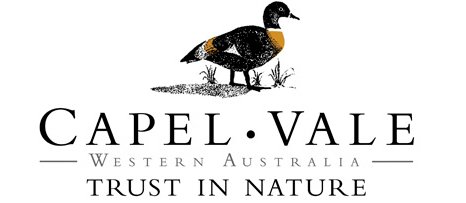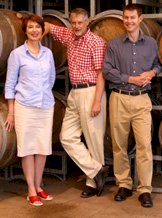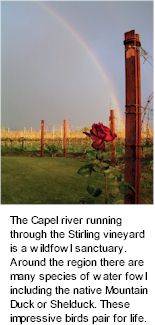


Capel Vale Winery, restaurant and cellar door, now sit atop the original vineyard site, Stirling Estate. Stirling Estate was originally the site of a stone fruit orchard in the 1930s. Consisting of rich, red alluvial loams over a limestone base, it possessed a natural, permanent watertable and was perfect for growing vines. The first plantings were in 1974, producing the first commercial vintage in 1980. After determining that the soils of the Capel area (now included in the EU registered Geographe Region) were best suited to Chardonnay and Merlot, it became the Prattens passion to determine the best region in South Western Australia for each of the main premium grape varieties.

The winemaking philosophy is to make intensely fruit driven, complex, powerful, yet elegant wines, from the regions most suited to each separate premium grape variety in Western Australia. Capel Vale now sources fruit from its own Stirling and Wellington vineyards in Capel, its Whispering Hill vineyard in Mount Barker, Sheldrake in Pemberton, and Madrigals, the latest development at Margaret River. Capel Vale has grown enormously, and now is one of the few major family owned wineries in Western Australia.
Capel Vale owns and operates seven vineyards in the four EU registered growing areas in South Western Australia, in total 500 acres (210 hectares). Each vineyard grows the most appropriate fruit appropriate for the climate and terroir. The winery's operation has played an important role in the establishment of the Western Australian Wine Industry and the recognition of South Western Australia as a premium grape growing region. The winery now exports to over fifteen countries. It's been an amazing journey from a few vines and a small tin shed!
The Whispering Hill vineyard is the most southern at Mount Barker, followed by Sheldrake at Pemberton, Madrigals at Margaret River and Stirling and Wellington at Capel in the increasingly recognised region of Geographe. All wine produced by Capel Vale is made at the winery on the Stirling Estate in Capel.

Capel Vale's vineyards in the Geographe region consist of Capel Stirling 1, Capel Stirling 2 and Capel Wellington, eighty acres in total. The first vines were planted on the Stirling Estate vineyard in 1974. The winery, bottling line, warehouse, tasting cellar and restaurant are now all located on this property. The vineyards are named after the original Capel shire subdivisions. The Stirling area being one of the earliest surveyed areas in the state, deriving its name from Captain James Stirling, the founding father of modern Western Australia.
The Pemberton area is enjoying increasing acclaim as a premium cool climate viticultural region producing elegant flavours and wines of note. Capel Vale's Sheldrake Vineyard was planted in the winter of 1995 to initially supplement and ultimately replace fruit sourced from the Pemberton region. The name 'Sheldrake' seemed a natural progression from our emblem, the Shelduck. The vineyards here support superb varietal vines.
When Capel Vale's Margaret River vineyard site was purchased the wide variety of native birds in the area inspired the name Madrigals. A madrigal is a part-song sung by several voices. The word voices is to be taken literally, the madrigal being a piece of vocal chamber music, dating back to the 1600s, intended to be performed with one singer to a part. It was noticed that the birds around the vineyard seemed to be singing in a madrigal style. Rather than all singing together it was as if each were awaiting their lines. Then, as if on cue, the next madrigal would perform their contribution to the recital.
The vineyard name, Whispering Hill was inspired by the noise that the wind makes when blowing through a stand of rare Casuarina trees, near a rocky outcrop on the property - making it indeed a Whispering Hill. Fruit from the vineyard has a long history of producing award winning wines. This began when the 1986 Capel Vale Riesling was awarded the Australian National Dry White Champion - against many other varieties of white wines. This particular wine was made by Capel Vale's owner and founder Dr Peter Pratten from 75% Mt Barker and 25% Capel fruit. The accolades have continued with the Whispering Hill Riesling receiving Top Gold at the Mt Barker Show.
